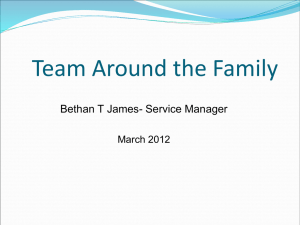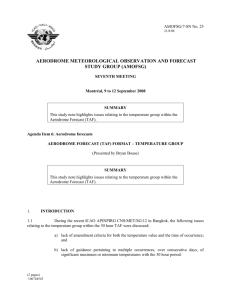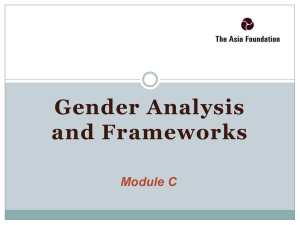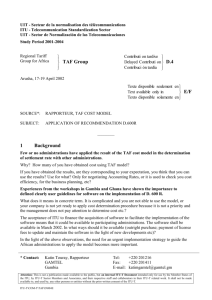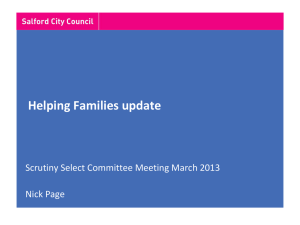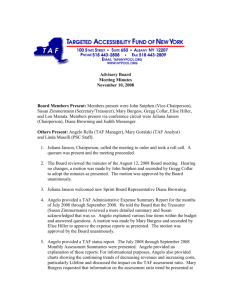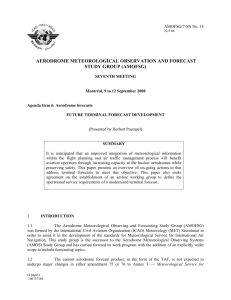amofsg
advertisement
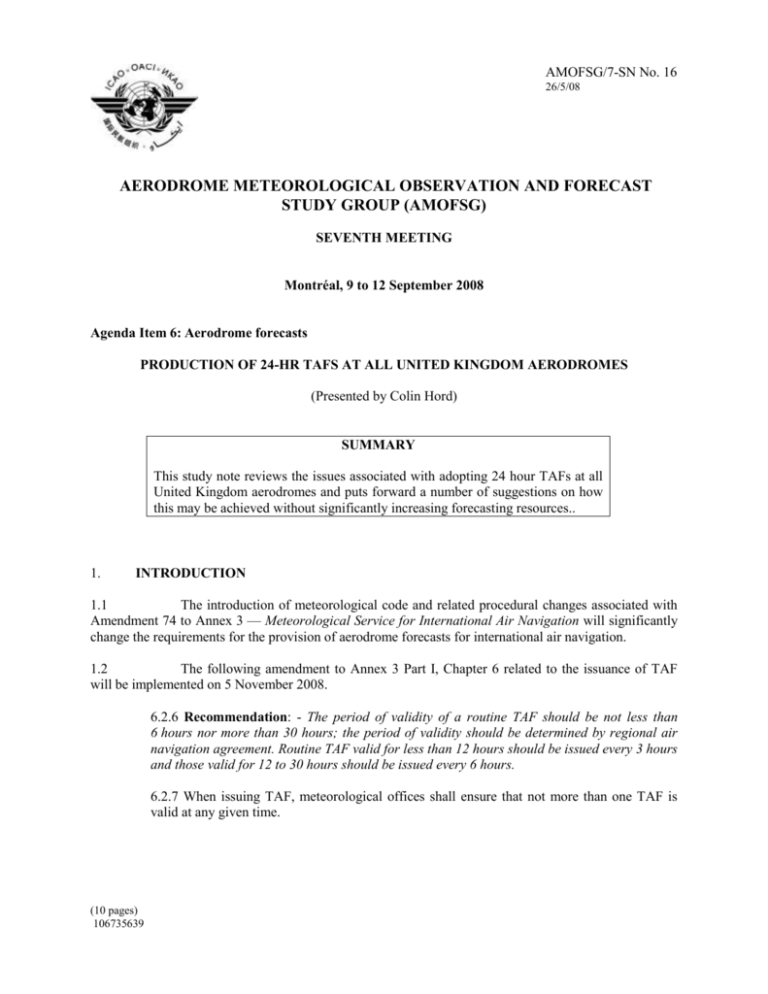
AMOFSG/7-SN No. 16 26/5/08 AERODROME METEOROLOGICAL OBSERVATION AND FORECAST STUDY GROUP (AMOFSG) SEVENTH MEETING Montréal, 9 to 12 September 2008 Agenda Item 6: Aerodrome forecasts PRODUCTION OF 24-HR TAFS AT ALL UNITED KINGDOM AERODROMES (Presented by Colin Hord) SUMMARY This study note reviews the issues associated with adopting 24 hour TAFs at all United Kingdom aerodromes and puts forward a number of suggestions on how this may be achieved without significantly increasing forecasting resources.. 1. INTRODUCTION 1.1 The introduction of meteorological code and related procedural changes associated with Amendment 74 to Annex 3 — Meteorological Service for International Air Navigation will significantly change the requirements for the provision of aerodrome forecasts for international air navigation. 1.2 The following amendment to Annex 3 Part I, Chapter 6 related to the issuance of TAF will be implemented on 5 November 2008. 6.2.6 Recommendation: - The period of validity of a routine TAF should be not less than 6 hours nor more than 30 hours; the period of validity should be determined by regional air navigation agreement. Routine TAF valid for less than 12 hours should be issued every 3 hours and those valid for 12 to 30 hours should be issued every 6 hours. 6.2.7 When issuing TAF, meteorological offices shall ensure that not more than one TAF is valid at any given time. (10 pages) 106735639 AMOFSG/7-SN No. 16 -2- 1.3 Following consideration at the seventeenth meeting of the Meteorology sub-group (MET/G/17) of the European Air Navigation Planning Group (EANPG) and subsequently confirmed by ICAO state letter, the European (EUR) air navigation plan (ANP) Volume 1 Basic ANP, Part VI - MET has been amended to reflect the global standardization of TAF issuance as follows:: a) routine TAF should be issued as required in respect of operational needs. They should have a period of validity of 9 hours, or of either 24 or 30 hours and be issued for designated aerodromes as specified in FASID Table MET-1A. b) the periods of validity for 9-hour TAF should commence at 00, 03, 06, 09, 12, 15, 18 and 21 UTC, and of TAF valid 24 or 30 hours at 00, 06, 12 and 18 UTC. The periods of validity should be adapted to the hours of operation of the aerodrome as agreed between the meteorological authorities and the operators concerned. The scheduled international exchange of TAF should be completed 30 minutes before commencement of the period of validity. c) the forecast maximum and minimum temperature together with their respective dates and times of occurrence should be included in aerodrome forecasts with a period of validity of 24 or 30 hours for certain aerodromes as agreed between the meteorological authority and the operators concerned. 1.4 Additionally, it is noted that United Kingdom operators as well as IATA have requested 24-hour TAF to be produced for all aerodromes, including those non-AOP aerodromes listed in the SADIS User Guide, Annex 1, whilst MET/G/17 has considered the merits of issuing all TAF every 3 hours. 1.5 This paper reviews the impact of Amendment 74 on United Kingdom TAF production and considers the issues raised by the new proposals outlined above. 2. DISCUSSION 2.1 In the United Kingdom from November 2008 there will be 54 aerodromes in receipt of a TAF, four 30 hour TAF locations, fourteen 24-hour TAF locations and thirty six 9-hour TAF locations (of which 16 are AOP aerodromes and 20 are non-AOP aerodromes). In the United Kingdom aerodromes that operate for 24 hours a day are almost all issued with a 24 hour TAF. 2.2 The majority of United Kingdom aerodromes do not operate 24 hours a day and close for some period overnight, this can range from 3 to over 8 hours at some smaller airports. 2.3 Since November 2007, airports that issue AUTO METARs when the airport is nonoperational have been able to have a TAF issued based on the AUTO METAR without having to wait for METARs that are produced by an accredited observer. However this requires the aerodrome to produce AUTO METARs that are compliant with ICAO Annex 3, i.e. contain all the required elements as per Chapter 4, Para 4.5.1. 2.4 TAF verification is carried out routinely for all airports, and provides an important tool for ensuring that forecasting standards are being maintained. TAFs can only be verified against a METAR that contains all the required parameters for the verification. -3- AMOFSG/7-SN No. 16 2.5 There have been a number of requests from United Kingdom operators and more recently the International Air Transport Association (IATA) to issue 24-hr TAFs from aerodromes that are not operational 24 hours a day. This would allow TAFs to be used for longer range flight planning, especially when planning for multi-sector flights or for flights that may be due to land close to the reopening of an aerodrome. It should be noted that in this context a TAF only becomes of greater use when the validity time extends past the reopening of the aerodrome. 2.6 METG/17 considered further additional proposals for simplifying the TAF issuance rules whereby a TAF is issued every 3 hours regardless of the validity period and a separate study note discusses these issues. 2.7 Whilst the benefits to airlines and others of having a 24-hr TAF for each aerodrome that enables improved forward planning are clear, there are 5 key meteorological issues associated with this proposal and the issuance of such TAF every 3 hours, from both an operational and regulatory perspective. These issues will be considered in turn: Issue 1 Nugatory forecasting When an aerodrome is closed it cannot be used by any operators, as a consequence the forecast for this period of time is unable to be utilised, while this may be a relatively small amount of time for some airports it could be as much as half the TAF period in some locations. In the United Kingdom it is the practise to only forecast for the period when the aerodrome is open. The additional time that the forecaster would have to spend on forecasting for this unusable period would require additional resources and ultimately increase TAF production costs. Issue 2 Constant review Annex 3 states in Chapter 6: 6.2.4 Meteorological offices preparing TAF shall keep the forecasts under continuous review and, where necessary, shall issued amendments promptly. 6.2.5 TAF that cannot be kept under continuous review shall be cancelled. In the United Kingdom a forecaster is required to keep the TAF under continuous review by monitoring the routine METAR, Should an aerodrome cease to issue METARs United Kingdom policy states that the forecaster must cancel the TAF. It should be noted that each TAF cancellation is additional work and would be a significant task if all 36 non H24 aerodromes that currently receive a 9 hr TAF were to be issued with a 24 Hr TAF and each individual TAF needed to be cancelled upon closure of the aerodrome. Issue 3 Verification Routine verification for all TAFs is carried out in the United Kingdom ensuring that forecast quality is being maintained, verification is an essential element of any Quality Management System. If a forecast were issued for a period of time when there might be no observations (i.e. when the aerodrome is closed) it would not be able to be verified. A change in working practises would be required to issue a TAF that spanned the time an aerodrome was closed. Ensuring that the forecaster maintained the level of forecasting quality for that time may prove to be challenging since they would be aware that the forecast could neither have its accuracy validated nor be used. This could be mitigated by the use of AUTO METAR, but for a number of States, including the United Kingdom, the cost of aerodrome AMOFSG/7-SN No. 16 -4- meteorological equipment is the responsibility of the aerodrome to procure and maintain. Many aerodromes are not in a position to equip their met offices to be able to produce such observations. Issue 4 Non standardised TAF issue times Currently the United Kingdom issues a TAF to an aerodrome once the meteorological office has received two METARs. It is noted that these times often do not relate to the standard TAF issue times, for example an aerodrome that becomes operational at 0800 and produces two METARs before this time would be issued with a 0806 TAF rather than the standard 0606 TAF. In this case the TAF is issued as a late addition (retarded) to the TAF bulletin. It would only be possible to adhere to the standard issue times if aerodromes were to issue AUTO METAR. Issue 5 3-hourly updates The proposed move to 3-hourly updates of all TAF leads to a significant increase in the number of TAF that would be required to be produced in the United Kingdom, with the associated resource implications. Clearly the forecaster must be in a position to issue amendments to forecasts if they reach the agreed amendment criteria but this is based on a continuous evolution of the forecaster’s understanding of the meteorological conditions and has a high priority over routine work. This is very different to a routine issue of a large number of TAF, which even though modern IT systems can be used, still takes a significant amount of input from the forecaster and diverts their attention from other work and monitoring of conditions. Further information on the additional amount of TAFs produced is given in the appendix to this paper. 2.8 Notwithstanding the above, the United Kingdom supports the intentions of IATA’s proposal for improved flight planning but suggests that in order to address the issues above, some additional changes are considered by the group: a) remove or amend the requirement to keep the forecast under continuous review (an amendment to Annex 3 could state only keep the TAF under continuous review if (i) the aerodrome is operating during its notified hours of operation or (ii) there is a continuous supply of observations This is not favoured as it appears to dilute the current Annex 3 standard to maintain a high-quality TAF and to issue amendments to it as soon as the forecaster becomes aware that the forecast has or will fall outside appropriate amendment critieria; b) not all aerodromes produce 24-hr TAF It is speculated that there may be a difference of opinion between users over which aerodromes should have 24-hr TAF and which should not, particularly in light of cost recovery issues pertaining to the nomination of diversion aerodromes; c) use of NIL within a TAF At present it is only possible to use NIL with a TAF, as the missing forecast identifier (see Annex 3 Appendix 5 Table A5-1). However, it (or some other indication) could be used within the body of the text to indicate that for a given period no forecast has been prepared, i.e. when the aerodrome is non operational for that time. -5- AMOFSG/7-SN No. 16 An example could be seen as follows, for an aerodrome that is closed between 2200 and 0500 UTC: TAF EGNH 060510Z 0612/0712 35010KT 7000 -RASN BKN020 TEMPO 0612/0614 2500 -SN BKN008 BECMG 0613/0615 9999 NSW PROB30 TEMPO 0615/0621 5000 SHRASN SCT030CB 0622/0705 NIL FM 060500 4000 BR BECMG 0706/0708 9999 NSW PROB40 TEMPO 0709/0712 3000 -SNSH SHRASN BKN010; and d) permit the use of non-standard validity times but only in the case of aerodromes that open between standard validity periods 3. CONCLUSION 3.1 Aerodromes should be encouraged by the operators to install automated observing equipment that enable AUTO METARs to be issued during non-operational hours, so ensuring that the TAF can be kept under constant review and not cancelled as soon as the aerodrome closes. 3.2 Increasing the TAF length for both AOP and non AOP aerodromes to 24 hours is likely to have a significant impact on the forecasting resources required to complete this task and would likely lead to increase costs for production. Careful consideration should be given to which aerodromes should be provided with 24 hr TAFs. 3.3 Consideration should be given to allow a the TAF to contain a “NIL” enabling the forecaster the ability to only provide a forecast for the period in which the aerodrome is operational. This would ensure that the forecast provided could be kept under constant review, since there was no forecast for the period when there were no observations were being provided as the aerodrome was closed This would also ensure that there was no nugatory forecasting, which as been noted can be significant for aerodromes that only open for relatively short periods of the day. 3.4 In view of the significant increase in the number of “TAF hours” that are required when a 24-hour TAF is issued every 3 hours, there should be careful consideration of the costs versus the benefits before such a requirement is introduced. 4. ACTION BY THE GROUP 4.1 The group is invited to consider the issues raised in this paper and, if necessary, ask the Secretary to develop appropriate revisions to the appendix to this paper. ———————— APPENDIX EXAMPLE FORECAST TIMELINES Some example forecast timelines are provided below (see Tables 1 & 2) for two typical airports in the UK that currently receive a 9 hr TAF, Blackpool (AOP listed) which closes from 2200 – 0600 and Campbeltown (non AOP listed) which has limited traffic and is closed from 1700-0800. For each airport three example timelines are shown, a 9 Hr TAF and a 24 Hr TAF issued at 6 and 3 hourly intervals. Each timeline is colour coded, orange shows when the aerodrome is open and the TAF is valid, red indicates the aerodrome is closed for that period of the TAF and white indicates that no TAF has been issued as the aerodrome is not open. At present the total number of hours for which a TAF should be produced each day for Blackpool is 54, however this is reduced to 47 hours by only issuing the TAF for the hours when the aerodrome is open. At Campbeltown there are 38 hours for which the 9 Hr TAF should be produced each day, here a reduction to 26 hours is made by only issuing the TAF for the operational hours. For the 24 hour TAFs, it can be seen that when issuing the TAF 6 hourly the number of hours to be forecasted at Blackpool rises to 90, however 26 hours (29%) are for when the aerodrome is closed and the forecast cannot be utilised. In the case of Campbeltown there are 36 hours of the TAF that would not be able to be utilised which represents 49% of the 74 hours for which a TAF is produced. Were the forecast be issued every 3 hours the number of TAF hours that are required to be forecast rises significantly, for Blackpool this becomes 183 hours of which 55 hours are for when the airfield is closed (30%). In the case of Campbeltown the number of TAF hours is 154 of which 80 are for when the airport is closed (52%). AMOFSG/7-SN No. 16 A-2 Appendix To summarize: Total Hours of TAF required in each 24 hour period 9 Hour TAF Blackpool 54 hours Campbeltown 38 hours 24 Hour TAF 24 Hour TAF issued 6 Hourly issued 3 Hourly 90 hours 183 hours 29 % when closed 30 % when closed 74 hours 154 hours 49% when closed 52% when closed AMOFSG/7-SN No. 16 Blackpool 9Hour TAF 0 6 0 8 Hours forecasted A-3 1 0 1 2 1 4 1 6 1 8 2 0 2 2 24 Hour TAF 6 hourly 0 0 0 2 0 4 0 6 0 8 1 0 1 2 1 4 1 6 1 8 2 0 2 2 0 0 0 2 0 0 4 5 TAF CNL Hours forecasted while aerodrome open 9 9 9 9 9 9 X 9 7 X 9 4 0 0 3 3 6 6 54 47 7 hrs forecasted when closed X X X X 24 hour TAF 3 hourly 24 16 24 16 24 16 18 16 90 64 26 hrs forecasted when closed X X X X X X X X 24 16 24 16 24 16 24 16 24 16 24 16 18 16 21 16 183 128 55 hrs forecasted when closed Table 1 - Forecast Timeline for Blackpool Table 2 Forecast Timeline for Campbeltown Appendix Campbelltown Hours forecasted 9 Hour TAF AMOFSG/7-SN No. 16 Appendix 0 0 6 8 1 0 1 2 1 4 1 6 1 8 2 0 2 2 0 0 0 2 0 4 0 6 0 8 1 0 1A-41 2 4 1 6 1 8 2 0 2 2 0 0 0 2 0 0 4 5 Hours forecasted if TAF ceases at airport closure 6 6 X 9 8 X 9 5 X 9 2 0 0 0 0 1 1 4 4 38 26 12 hrs forecasted when closed 24 Hour TAF 6 hourly X X X X 24 11 24 24 10 9 16 9 74 53 36 hrs forecasted when closed 24 Hour TAF 3 hourly X X X X X X X X 24 11 24 24 24 24 24 24 10 9 13 9 16 9 19 9 154 119 80 hrs forecasted when closed — END —
